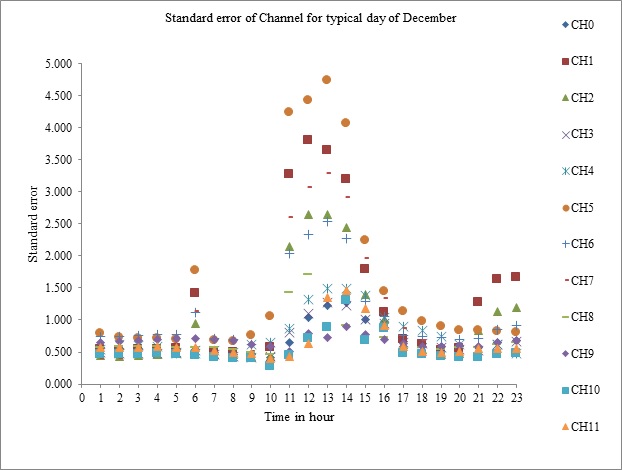Experimental Studies on Solar Chimney for Building Space Heating and Ventilation Enhancement: Energy, Exergy and Economic Analysis

DOI:
https://doi.org/10.54060/jmce.v2i2.21Keywords:
Energy, exergy, techno-economic analysis, CO2 mitigation, Passive heating and cooling of buildingsAbstract
Solar chimneys are with or without heat storage widely used for improving the ventila-tion and thermal comfort in buildings. The energy, exergy, economic analysis of solar chimney and the CO2 mitigations (EEEC) are evaluated in this communication. The im-proved solar chimney with MS plate and MS box was designed and developed by the author in the CBRI Roorkee. The observations of typical day of December have been taken for the presentation and the whole month data have been used to evaluate the EEEC parameters. The maximum energy efficiency has been observed by 26.68% during 12 hours of the typical day, and at the same time the exergy efficiency has obtained 3.69%. Approximately 2285kWh energy can be saved during a year through solar chimneys. The payback period of an improved solar chimney with MS plate (SCWMSP) is estimated to be less than one year and with MS box (SCWMSB)) it is likely to be one year. CO2 can also be saved with the energy conservation parameter observed saving of 4.37 ton / year CO2 by SCWMSP, on the other hand if SCWMSB have implemented than CO2 would be save by 5.51 ton/year.
Downloads
References
S. Lal, S.C. Kaushik, P. K. Bhargava. “Solar Chimney: A Sustainable Approach for Ventilation and Building Space Conditioning,”. International journal of Development and Sustainability, vol.2, iss. 1, pp. 277-297, 2011.
S. Lal, S. C. Kaushik, and P. K. Bhargava, “A case study on solar chimney-assisted ventilation for residential building in India,” Int. J. Energy Sect. Manag., vol. 7, no. 4, pp. 478–490, 2013.
Y. Chen, L. Feng, S. Tang, J. Wang, C. Huang, and M. Höök, “Extended-exergy based energy return on investment method and its application to shale gas extraction in China,” J. Clean. Prod., vol. 260, no. 120933, pp. 1-10, 2020.
T. J. Kotas, “The Exergy Method of Thermal Plant Analysis”. Reprinted, Butterworth’s, London,1995
I. Dincer, “Thermodynamics, Exergy and Environmental Impact,” Energy Sources, vol. 22, no. 8, pp. 723–732, 2000.
I. Dincer, “The role of exergy in energy policy making,” Energy Policy, vol. 30, no. 2, pp. 137–149, 2002.
Wall published a book on exergetics, 1998, http://www.exergy.se › ftp › exergetics assesses on August 12, 2022
G. Wall, “Tools for sustainable energy engineering,” in Proceedings of the World Renewable Energy Congress – Sweden, 8–13 May, 2011, Linköping, Sweden, 2011.
S. O. Onyegegbu and J. Morhenne, “Transient multidimensional second law analysis of solar collectors subjected to time-varying insolation with diffuse components,” Sol. Energy, vol. 50, no. 1, pp. 85–95, 1993.
A. Hepbasli, “A key review on exergetic analysis and assessment of renewable energy resources for a sustainable future,” Renew. Sustain. Energy Rev., vol. 12, no. 3, pp. 593–661, 2008.
K. Altfeld, W. Leiner, and M. Fiebig, “Second law optimization of flat-plate solar air heaters Part I: The concept of net exergy flow and the modeling of solar air heaters,” Sol. Energy, vol. 41, no. 2, pp. 127–132, 1988.
S. Farahat, F. Sarhaddi, and H. Ajam, “Exergetic optimization of flat plate solar collectors,” Renew. Energy, vol. 34, no. 4, pp. 1169–1174, 2009.
M. K. Gupta and S. C. Kaushik, “Performance evaluation of solar air heater for various artificial roughness geometries based on energy, effective and exergy efficiencies,” Renew. Energy, vol. 34, no. 3, pp. 465–476, 2009.
M. K. Gupta and S. C. Kaushik, “Exergetic performance evaluation and parametric studies of solar air heater,” Energy, vol. 33, no. 11, pp. 1691–1702, 2008.
S. Lal, “Experimental, 2014. CFD simulation and parametric studies on modified solar chimney for building ventilation”. Applied solar energy (Springer), Vol. 50, iss. 1, pp. 37-43, 2014.
S. Lal, “CFD simulation for feasibility study of a modified solar chimney applied for building space heating,” World Journal of Modelling and Simulation, vol. 10, no. 4, pp. 293–307, 2014.
A. Bejan, “Extraction of exergy from solar collectors under time-varying conditions,” Int. J. Heat Fluid Flow, vol. 3, no. 2, pp. 67–72, 1982.
A. Bejan, D. W. Kearney, and F. Kreith, “Second law analysis and synthesis of solar collector systems,” J. Sol. Energy Eng., vol. 103, no. 1, pp. 23–28, 1981.
Petela R. Engineering thermodynamics of thermal radiation for solar power utilization. Mc Graw Hill, 2010, pp. 126-145.
Holman J.P., Heat Transfer, TMH 2002, pp.646.
Incropera and Dewitt, Principles of Heat and Mass Transfer, Wiley India Edition 2018
Holman JP. Experimental Methods for Engineers. Tata McGraw-Hill, 2010.
B. Chandrasekar and T. C. Kandpal, “A preliminary evaluation of financial incentives for renewable energy technologies in India,” Int. J. Energy Res., vol. 28, no. 10, pp. 931–939, 2004.
North Carolina Division of Air Quality. Report on Greenhouse Gas Emission Guidelines: Stationary Combustion Sources. Available from: /http: //www. ncair.org/ monitor/eminv/forms/Stationary_Combustion_Sources.pdf's (retrieved in January, 2013).
M. L. Mittal, C. Sharma, and R. Singh, Estimates of emissions from coal fired thermal power plants in India. International emission inventory conference. Tampa, Florida, 2012.

Downloads
Published
How to Cite
CITATION COUNT
Issue
Section
License
Copyright (c) 2022 Dr. Shiv Lal

This work is licensed under a Creative Commons Attribution 4.0 International License.
























